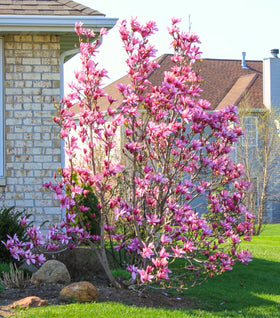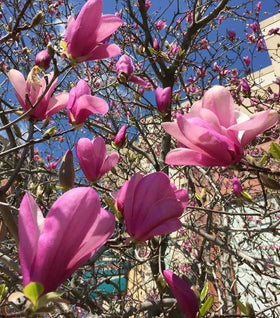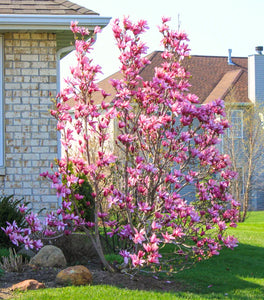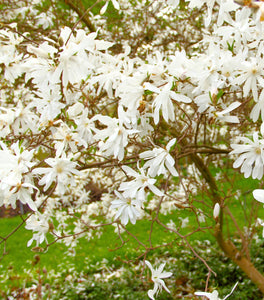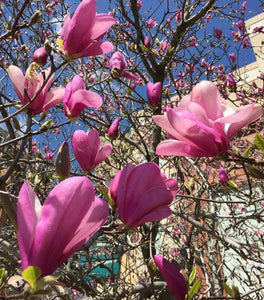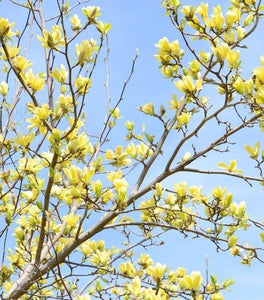Images Depict Mature Plants
Magnolia Pink Pyramid Trees for Sale Online
Magnolia Pink Pyramid is a new cultivar that was developed in New Zealand. It is a small tree that, after ten years, will reach about 12 feet high and 5 to 6 feet wide. It is ideal for smaller gardens or planting in a large pot on a patio or balcony in warmer climates.
The foliage is dark green, and the flowers range from purple to dark pink. The flowers can be up to 7 inches across. Pink Pyramid begins flowering at an early age and blooms in the spring before the foliage emerges and occasionally reblooms in the summer.
| Hardiness Zone: | 5-9 |
|---|---|
| Mature Height: | 10 to 12 Feet |
| Mature Width: | 5 to 6 Feet |
| Classification: | Flowering tree |
| Sunlight: | Full sun to partial shade |
| Habit: | Upright |
| Foliage: | Green |
| Flower Color: | Purple to Deep Pink |
| Soil Condition: | Any well drained soil |
| Water Requirements: | Water well until established |

How to Care for Magnolia Pink Pyramid
Be sure to read our planting instructions to ensure a healthy and happy plant for years to come!
How do I plant a Magnolia Ann Tree?
We suggest when planting your newly purchased Magnolia Ann plants that you dig a hole twice as wide as the root system but not deeper. The most common cause of plant death after transplanting is planting the new plant to deep. Depending on the quality of your existing soil you may need to add a locally sourced compost or topsoil to the back-fill soil. We do not recommend using straight topsoil or compost as a back-fill soil because more times than not these products will retain entirely to much moisture and will cause the root system to rot. Adding compost or topsoil will help the young feeder roots of Magnolia Ann to spread through the loose, nutrient rich soil, much easier than if you used solely the existing soil which more times than not will be hard and compacted.
How do I water the Magnolia Ann?
After back filling and lightly compacting the 50/50 mix of existing soil and compost give the Magnolia Ann a good deep watering. This is not to be rushed. Most of the water you put on the plant at first will run away from the plant until the soil is soaked. A general rule of thumb is to count to 5 for every one gallon of pot size. For example a one gallon pot would be watered until you count to 5 a three gallon pot would be 15 and so on. Check the plant daily for the first week or so and then every other day there after. Water using the counting method for the first few weeks. Gator Bags are a good investment that will help minimize the watering chore.
How do I fertilize the Magnolia Ann?
Trees such as Magnolia Ann grow best if they are fertilized lightly in the spring once frost has passed with a well-balanced, extended-release, fertilizer such as espoma Tree-tone. Fertilize Magnolia Ann again 6 to 8 weeks later to encourage denser foliage or faster growth of young trees. We recommend Bio-Tone fertilizer when planting. Either chemical fertilizers or organic matter can be used successfully with Magnolia Ann. Since an organic method of applying manure and/or compost around the roots, produces excellent results and also improves the condition of the soil, this would be an excellent first line of attack. Organic additions to the soil can also be combined with a shot of chemical fertilizer for maximum effect.
How do I mulch the Magnolia Ann?
We highly recommend that you mulch your Magnolia Ann with either a ground hardwood mulch or a ground cypress mulch depending on your local availability. Any type of mulch will do but cypress or hardwood mulch will be of a higher quality and provide better nutrition overall as they breakdown. Mulching helps to keep weeds away which will compete with your new investment for water and nutrients. A 2 to 3 inch layer of mulch is sufficient but remember to take care not to cover any part of the stem of the plant with mulch. Its better to leave a one inch gap of space between the mulch and the stem or trunk of the plant.





